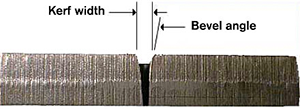Different cutting applications require different levels of cut quality. This might be important because the cut edge will be visible to the buyer of the finished part or product. In other cases, cut quality matters due to its impact on downstream processes, such as welding or painting; weld-ready cuts will reduce the need for weld preparation, streamlining production and reducing labor costs. There are also times when cut quality is of lesser importance, and operators may opt to trade cut quality for higher throughput.
Cut quality is determined by a number of factors including:
-
Whether the power level of machine is well-matched to the thickness of the material being cut
-
What gases (or in the case of waterjet, abrasives) are being used
-
Whether the machine settings and cutting consumables are properly matched
With some processes, especially oxyfuel cutting, the skill of the operator may be the most significant variable in determining cut quality. Other processes do not rely nearly as much on operator skill and, when process expertise can be built into cutting software, such as with Hypertherm's SureCut™ technology, the need for skilled operators is further reduced.
The quality of a cut is assessed according to the following properties:
-
Angularity – a cut with little to no angle is considered best
-
Kerf or width − a smaller kerf width enables finer part detail

-
Tolerance – tighter tolerances mean a more precise, repeatable cut
-
Size of the heat affected zone − a smaller zone protects the integrity of the metal better and impacts the viability of other processes such as welding and tapping
-
Dross – less is generally better (dross is metal that melts during the cutting process and remains attached to the edges of the cut)

-
Edge quality − smoothness of the finish

- Torch height control (THC) performance


